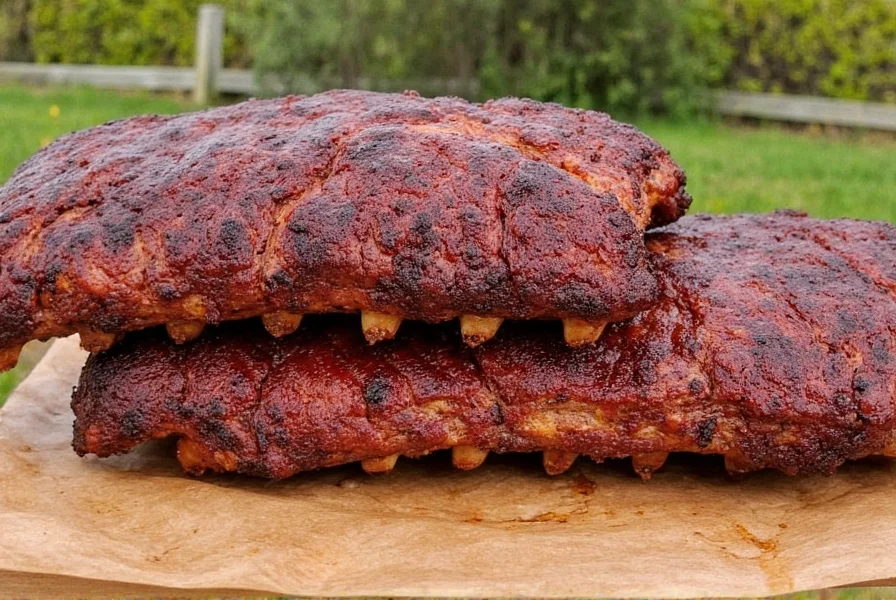Learn how to smoke St. Louis ribs perfectly with this step-by-step guide. From selecting the right cut to mastering smoking techniques, you'll get tender, flavorful ribs every time.
| Cut Type | Texture | Meat Distribution | Ideal For |
|---|---|---|---|
| St. Louis Ribs | Firm but tender | Well-marbled, even meat coverage | Barbecuing, slow smoking |
| Spare Ribs | Looser, fattier | Uneven thickness | Slow roasting, stewing |
| Back Ribs | Tender, leaner | Less meat per bone | Quick grilling, indoor cooking |
Choosing the Right Cut
When shopping for St. Louis ribs, look for racks that are pinkish-red with good marbling and a fat cap no thicker than 1/4 inch. Avoid grayish or dry-looking meat, which indicates older cuts.
Key Features to Look For:
- Fresh, moist appearance
- Even meat distribution across bones
- No strong odor

Rub & Seasoning Tips
Apply a balanced dry rub for maximum flavor penetration. Key ingredients include brown sugar (for bark formation), paprika (color and earthiness), garlic/onion powder (depth), black pepper (heat), and optional mustard or chili powder for complexity.
Pro Tip:
Let the rub sit overnight in the fridge to allow spices to penetrate deeply.
Smoking Methods & Techniques
Smoke at 225°F-250°F for 4-6 hours using indirect heat. Ideal woods include apple (mild/sweet), cherry (fruity), hickory (bold), and oak (balanced).
Temperature Setup Tips:
- Charcoal smoker: Use indirect heat with water pan
- Offset smoker: Control airflow via vents
- Electric smoker: Monitor temperature stability
| Method | Pros | Cons | Flavor Impact |
|---|---|---|---|
| Foil | Speeds cooking, keeps meat moist | Can make bark mushy | Milder, sweeter flavor |
| Butcher Paper | Retains moisture without destroying bark | Requires practice to wrap properly | Richer, smokier finish |
Finishing Touches: Saucing & Serving
Apply sauce only in the last 10-15 minutes of cooking to prevent burning. Popular styles include Kansas City (sweet/thick), Memphis (tangy/vinegar), Carolina (mustard-forward), and Texas (peppery/thin).
Essential Tools & Products
Must-Have Tools:
- Wire mesh gloves for safe handling
- Instant-read thermometer (target 195-205°F internal temp)
- Rib rack for better airflow
- Pink butcher paper or heavy-duty foil for wrapping
| Rub Brand | Flavor Profile | Best For |
|---|---|---|
| Stubb's Original Bar-B-Q Rub | Mild, sweet, smoky | Beginners |
| Spiceology Hog Wild | Bold, salty, peppery | Experienced grillers |
| Mrs. Dash Original Blend | Low sodium, herb-forward | Health-conscious cooks |
| Model | Type | Temp Control | Price Range |
|---|---|---|---|
| Char-Griller Akorn Kamado | Kamado | Excellent | $450 |
| Weber Smokey Mountain | Vertical Water Smoker | Good | $400 |
| Masterbuilt Electric Smoker | Electric | Very Easy | $350 |
FAQ: Common Questions Answered
Q: Can I smoke ribs on a gas grill?
A: Yes! Set one side to low heat, add soaked wood chips in a foil packet, and cook indirectly for delicious results.
Q: How long do I smoke ribs at 225°F?
A: 4-6 hours depending on rack size. Wrap around the 3-hour mark for optimal tenderness.
Q: Do I need to remove the membrane?
A: Absolutely. Peel off the silver skin membrane before applying rub to allow seasoning penetration.
Q: What's the ideal internal temperature for ribs?
A: 195-205°F. This breaks down collagen for melt-in-your-mouth texture.
Q: Should I spritz my ribs during smoking?
A: Spritz every 45-60 minutes after the first 2 hours with apple juice or vinegar to maintain moisture, but avoid overdoing it to prevent cooling the meat.
Q: How do I know when ribs are done without a thermometer?
A: Perform the bend test: pick up the rack with tongs. If it bends easily and cracks slightly, with meat pulling back 1/4-1/2 inch from bones, they're done.
Q: Why are my ribs tough even after reaching temperature?
A: This usually means collagen didn't fully break down. Extend cook time, wrap earlier, and ensure membrane removal for proper tenderization.
Conclusion
Smoking St. Louis ribs requires patience and precision, but following these steps guarantees tender, flavorful results every time. Remember: proper prep, consistent temperature, and attention to detail make all the difference.










 浙公网安备
33010002000092号
浙公网安备
33010002000092号 浙B2-20120091-4
浙B2-20120091-4